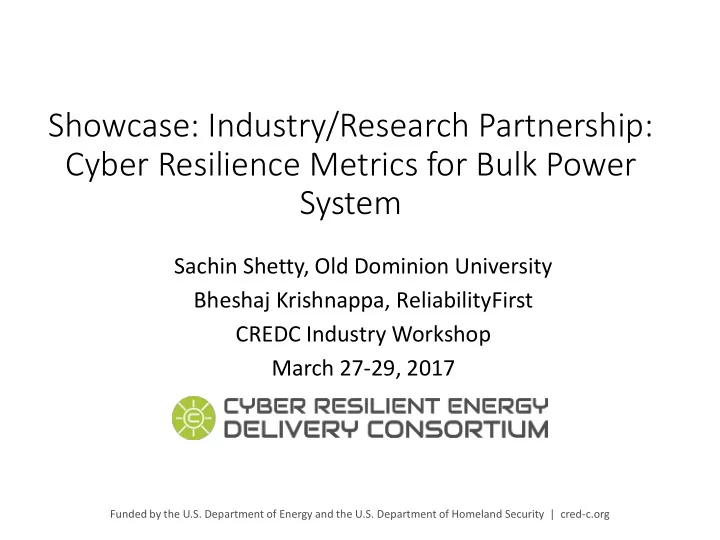

Showcase: Industry/Research Partnership: Cyber Resilience Metrics for Bulk Power System Sachin Shetty, Old Dominion University Bheshaj Krishnappa, ReliabilityFirst CREDC Industry Workshop March 27-29, 2017 Funded by the U.S. Department of Energy and the U.S. Department of Homeland Security | cred-c.org
Outline • Collaborative Research Agreement • Industry Relevance • Partnership Establishment • Research Motivation • Research Challenges • Research Approach • Overcoming Hurdles • Technology Transition Plan • Milestones and Deliverables
Collaborative Research Agreement • Research Agreement Goal • Derive metrics to evaluate cyber resilience • ReliabilityFirst (RF) will provide industry knowledge. • Research Agreement Purpose • Collaborative project between Old Dominion University and RF to develop cyber resilience metrics for bulk power system • Advance RF’s mission of promoting grid reliability and resiliency. • Provide industry relevance for CREDC research based on data and RF expertise • Performance Period – Q2 2016 – Q2 2017
Abou out RF t RF • RF is one of the eight FERC approved regional entities responsible for ensuring the reliability of the BPS. • RF is responsible for the reliability and security of the power system within a footprint which spans 13 states in the Eastern Interconnection. • Mission involves developing, monitoring, and enforcing compliance with the FERC approved reliability standards for owners, operators and users of the BPS (approximately 230 utilities) • Developing and disseminating timely and instructive information to enhance the reliability of the BPS; • Provide seasonal and long-term assessments of BPS reliability.
Industry Relevance • Develop techniques to compute cyber resilience metrics for BPS. • Opportunity to provide the BPS stakeholders with improved mechanisms or methods to quantify cyber resilience and increase reliability. • Proposed project will provide methods to quantify and measure cyber resilience. • Characterize the ability of the BPS infrastructure to ensure operational resilience in presence of cyber attacks • Monitor and simulate scenarios to improve the resilience.
Partner ership E Establishmen ent • Initial Meeting • First CREDC industry workshop, March 2016 • Follow on Discussions • Several meetings to identify a research project which addresses EDS gaps and relevant to RF and their stakeholders. • Research Project Identification • SDN based EDS Risk assessment research activity not a good fit • Developed new research activity for BPS cyber resilience metrics • Research Collaboration and Work • Established the mechanism between ODU and RF • Started working on the project from Q3 2016
Research Motivation • Availability of BPS cyber resilience metrics will support risk management and mitigation decisions. • Provide quantitative insights to ensure operational resilience and assist in development of cost-effective mitigation plan. • Motivate BPS operators to continually assess their resilience capabilities and benchmark their performance
Resea earch Challen enges es • Understanding the North American BPS which is a complex technological network comprising of large number of system states, dynamic operating conditions, complex network configurations, wide variety and geographically distributed assets and attack paths • Existing models for power grid structural resilience focus on graceful degradation in presence of failures, hence the need to quantify graceful degradation • Quantifying cyber resilience is challenging • Resilience of a system depends critically on defining acceptable system performance • Cyber resilience metrics for BPS vulnerable to cyber threats needs to be developed • Lack of methods to quantify cyber resilience metrics
Research Approach • Understanding the factors impacting resilience of BPS in terms of availability of essential services • Utilize and simulate the analytical models to study resilience using the knowledge of BPS Infrastructure, network topologies, firewall configurations, communication technologies, etc. • Verify and validate the numerical results for BPS cyber resilience metrics • Measure cyber resilience for power systems as a function of robustness, redundancy, resourcefulness and rapidity.
Research Approach • Robustness —the ability of systems, system elements, and other units of analysis to withstand disaster forces without significant degradation or loss of performance; • Redundancy —the extent to which systems, system elements, or other units are substitutable, that is, capable of satisfying functional requirements, if significant degradation or loss of functionality occurs; • Resourcefulness —the ability to diagnose and prioritize problems and to initiate solutions by identifying and mobilizing material, monetary informational, techno- logical, and human resources; and • Rapidity —the capacity to restore functionality in a timely way, containing losses and avoiding disruptions. Source: Bruneau, M., S. E. Chang, R. T. Eguchi, G. C. Lee, T. D. O’Rourke, A. M. Reinhorn, M. Shinozuka, K. Tierney, W. A. Wallace, and D. von Winterfeldt. A Framework to Quantitatively Assess and Enhance the Seismic Resilience of Communities. Earthquake Spectra, Vol. 19, No. 4, 2003, pp. 733–752.
Overcoming Hurdles • Access to data to validate the proposed theoretical framework • In our effort, the data requirements were knowledge of BPS Infrastructure, network topologies, firewall configurations, communication technologies, etc. • We were able to acquire the information that was relevant to validate our technique based on weekly discussions with RF
Technology Transition Plan Develop tools to measure robustness, redundancy, • rapidity and resourcefulness properties of BPS in the presence of cyber threats. Qualitative - Develop tool which provides BPS operators with a • qualitative approach to self-assess the cyber resilience indicators Quantitative – Develop tool which provides cyber resilience • metrics for BPS operators based on their operating assets and conditions
Milestones and Deliverables • Q4, 2016 – Completed research paper on graph- theoretic framework to measure cyber resilience of BPS that takes into account the ability to tolerate N-K contingencies. • Q2, 2017 – Preliminary version of qualitative tool to assess security posture of RF stakeholders • Q3, 2017 – Preliminary version of quantitative tool which implements proposed framework to provide cyber resilience metrics for utility companies.
http://cred-c.org @credcresearch facebook.com/credcresearch/ Funded by the U.S. Department of Energy and the U.S. Department of Homeland Security
Recommend
More recommend